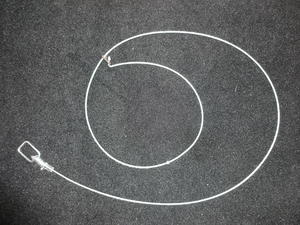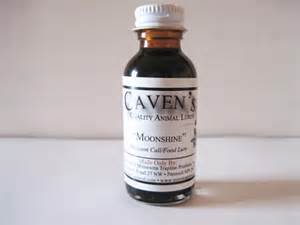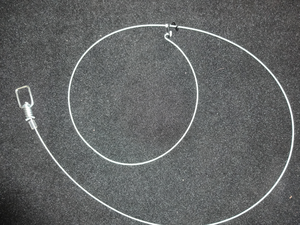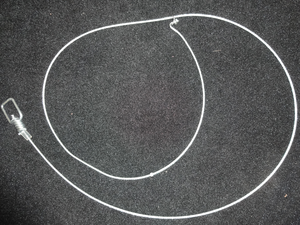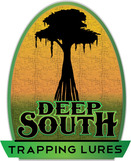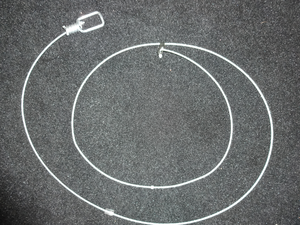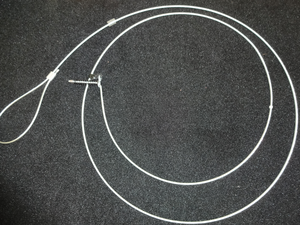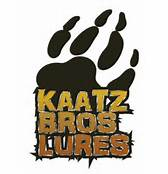Snaring Basics Information
BASICS OF SNARING
Animals naturally follow the path of least resistance unless a strong reason compels them otherwise. This behavior is what makes snaring such an effective method. In areas where raccoons, foxes, or coyotes roam, identify paths, gullies, log crossings, fences, culverts, or other features that guide their LINE OF TRAVEL, and set a snare EXACTLY IN THE CENTER of this path. These animals encounter countless small obstacles—like branches, weeds, or vines—during their travels and will typically walk right into a snare, mistaking it for just another natural obstruction. They won’t realize they're caught until it’s too late.
Snaring is quick, simple, and efficient.
Recommended Loop Sizes and Heights:
Animal
|
Loop Diameter
|
Height off Ground
|
Groundhog, Opossum
|
5-6”
|
2”
|
Fox
|
8”
|
8”
|
Bobcat
|
8”
|
8”
|
Raccoon
|
6-8”
|
3-5”
|
Coyote
|
10-12”
|
10-12”
|
Wolverine
|
8”
|
8”
|
Beaver
|
10”
|
2-3”
|
Wild Hog
|
Up to 18”
|
10-12”
|
Wolves
|
18”
|
10-12”
|
Important Tips:
-
Secure the snare firmly—even more so than you would a standard trap. Captured animals will pull with their full strength, often using all four legs.
-
For larger animals like hogs and wolves, anchor the snare as high off the ground as possible. This minimizes their leverage, reducing the chance of escape and ensuring they remain in place until checked.
Southern Snares swiveled snares feature swivels compatible with 3/8” or 1/2” rebar stakes. You can also thread the snare loop through the swivel to anchor it to trees or other objects as needed.
CHOOSING THE RIGHT SNARE
1. State Regulations
Always check your local snaring laws. It's your responsibility to adhere to these regulations. For convenience, links to state-specific rules are available under the "Customer Service" section at the bottom of our webpage.
2. Cable Selection
When choosing cable, consider the type, construction, diameter, and length.
-
Cable Types:
-
Galvanized Aircraft Cable (GAC): Durable, coated with zinc for rust resistance, and widely used in snaring.
-
Stainless Steel Cable: Rust-proof, strong, and ideal for salty or wet conditions, though not entirely chew-proof.
-
Cable Construction:
-
7x7: Popular for its balance of strength and flexibility.
-
7x19: Extremely flexible, ideal for large animal foot snares.
-
1x19: Stiff and smooth, preferred for dispatch snares due to its speed when “loaded.”
-
Cable Diameter: Match the diameter to your target animal.
-
1/16”: Fox, bobcat, rabbit, etc.
-
3/32”: Versatile and suitable for coyote, raccoon, and beaver.
-
1/8” or larger: Required for stronger animals like bears and wolves.
-
Cable Length: Adjust length based on target species and setting conditions:
-
30”-48”: Squirrels, mink, rabbits.
-
60”-72”: Coyotes, raccoons, beaver.
-
96”-110”: Wolves and hogs.
3. Anchoring Options
Your snare’s end design depends on the anchoring system you prefer. Options include adjustable loops, solid loops, and swivels.
4. Snare Locks
Locks are crucial for holding animals in the snare.
-
Relaxing Locks: Ideal for live captures and reduced fur damage.
-
Non-Relaxing Locks: Tighten as the animal resists, great for dispatch setups.
-
Mechanical Locks: Aggressive and effective, often used for rapid kills.
5. Support Collars
These collars stabilize your snare by attaching it to a support wire, keeping the loop properly positioned. Two popular snare supports are the poly support (which is the most popular) and the universal snare support, which resembles as small spring
6. Deer Stops/Live Catch Stops
Deer stops prevent the loop from fully closing, allowing non-target animals (like leg-caught deer) to escape.
We use free floating deer stops on all our snare unless they are for a state or region that requires it by law. By adding a free floating deer stop, this gives the customer the option to use it or or to leave it free floating and not use it.
7. Breakaway Devices
Breakaway systems ensure safety and compliance with regulations, releasing animals like deer or livestock when necessary. there are a few different types of Break Away Devices, (B.A.D.'s) S-hook BAD's work with Cam Locks or Wedge locks and have two basics strengths 285 and 350 lbs. J-Hook BAD's work well with most other locks such as washer locks, Mini Pro Locks, LoPro locks Etc. and come in two strengths' 285 and 350 lbs. Release ferrules are crimped on using a special tool and have a slightly lower profile compared to J and S hooks BAD's. Break away locks are another style where the lock will actually break apart at a certain poundage. Some states don’t accept breakaway locks as a breakaway device.
8. Dispatch Springs
These springs increase lock pressure, enhancing efficiency in entanglement setups. They are not legal everywhere, so check regulations.
ADVANTAGES OF SNARING
-
Cost-Effective: Snares are affordable, many dozens of snares can be bought for the price of just a few traps
-
Portable: Easy to carry, even in remote locations. lite weight and compact you can pack several dozen in a pack and still be lighter in weight than a few traps
-
Efficient: Low maintenance and highly effective with minimal effort.
-
Adaptable: Useful for a variety of terrains and target species.
Need assistance? Our team at Southern snares and Supply is here to help with advice and recommendations. Don’t hesitate to call or visit our website for support!
SNARE PARTS
-
Swivel - Enables the snare to rotate on the stake, preventing the cable from twisting and ensuring the animal’s comfort. The snare swivel also helps maintain the cables integrity so it does not bind or kink up as bad
-
-
Support Collar - Often called a wammy. Once the snare loop is set to the desired size, the support collar is slid next to the lock. A pigtail support or nine-gauge wire is inserted into the support collar, then adjusted to position the loop precisely as needed.
-
-
Lock - Keeps the snare loop from reopening after a catch is made.
-
-
Deer Stop - Limits how small the snare loop can close, allowing leg-caught deer to escape.
-
-
Steel Cable Ends or Aluminum Stops - Secure the ends of the snare cable and hold all components together.
With so many options available, choosing the right snaring setup can feel overwhelming. For expert guidance and quality products, Southern Snares is an excellent resource to help you make informed decisions.



